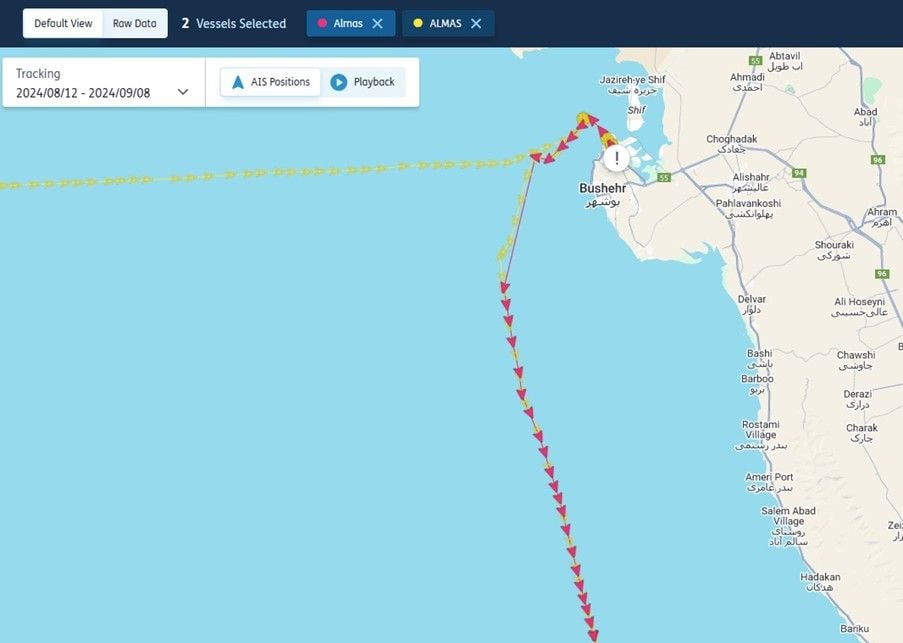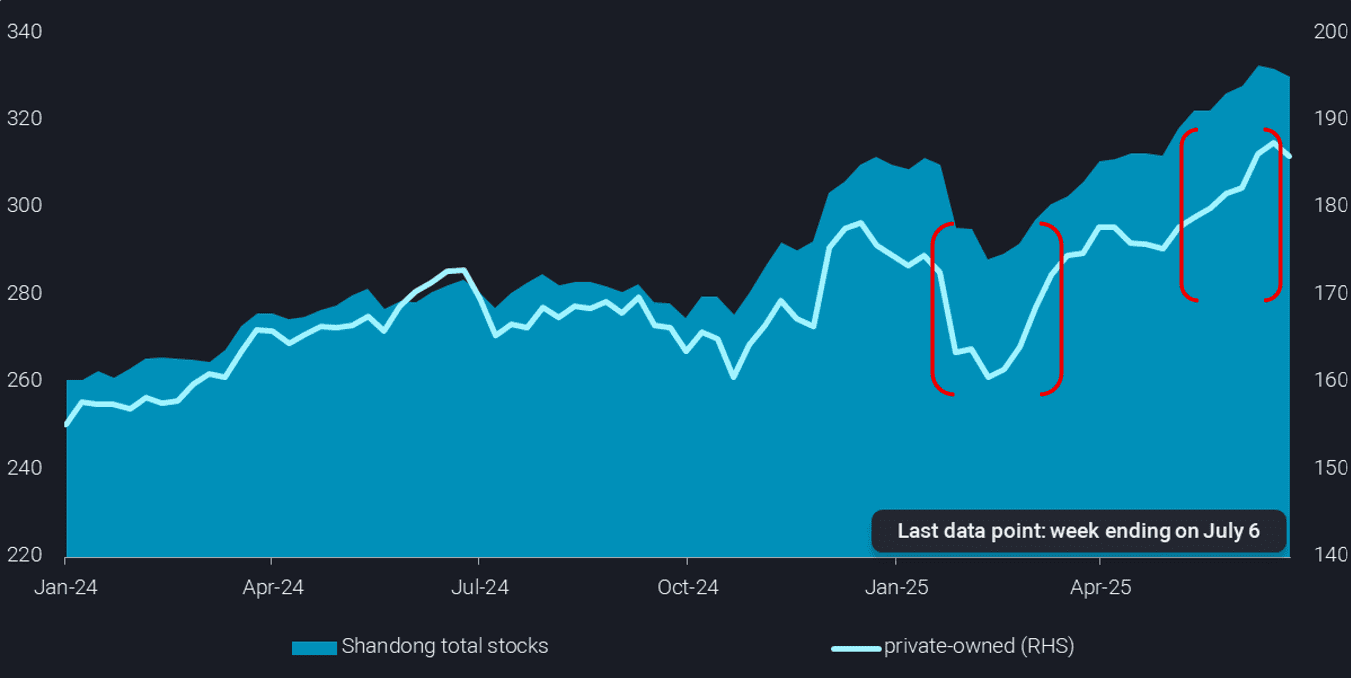10-Year Look at Shipping Seasonality Amid Black Swan Disruptions 📉 Iran shipments to Houthis a masterclass in AIS manipulation 📡 China’s Iranian crude imports near record high, again 🛢️
|
Maritimedata.ai is a single source of access to 200+ data services. 200+ Products 60+ Maritime Intelligence Providers 30+ Years of Experience Insights 📈Oil & Gas 🛢️
Dry 🚢
Other 🌎
Iran shipments to Houthis a masterclass in AIS manipulation - Lloyd's ListThe Houthis have a robust weapons supply chain and there are limited options for interrupting these networks
Despite US and Israeli air strikes on Houthi bases and reports of some seizures of dhows carrying weapons heading into Houthi territory, security analysts have been warning that weapons and components have continued to flow into Yemen. Intelligence reports suggest that the Houthis continued to restock critical components to assemble ASBMs locally, but also managed to receive a number of additional munitions. That restocking process has been happening for several months. A Lloyd’s List investigation gives a small insight into this opaque supply chain, revealing the sophisticated manipulation used to complicate efforts to track shipments and difficulties in disrupting these operations. In its 2024 report, the UN panel of experts identified six vessels for calling at Houthi-controlled ports without receiving clearance from the UN Verification and Inspection Mechanism. UNVIM is a body that monitors and inspects cargo bound for Yemeni ports not under the internationally recognised government’s control. Its purpose is to facilitate trade into these ports while helping to uphold the arms embargo. Comoros-flagged aggregates carrier Almas (IMO: 8864957), can be tracked using Automatic Identification System data calling at Hodeidah in October 2023.
Almas did not stop in Djibouti, where UNVIM is based and inspections are carried out, after sailing from Iran. The entire voyage can be viewed using AIS positions, but an assessment of the messages reveal the efforts taken to conceal the ship’s identity and movements. Almas never actually transmits its International Maritime Organization number over the course of the voyage. This is because the ship stopped using a class A AIS transponder in October 2022, transmitting only through a class B system from that point onwards. Class B transponders are designed for smaller vessels. They generally have a smaller data package, with many of the data fields being empty or reporting “not available”, including the IMO number. The data is also not reported as often as class A. “It’s kind of like pulling up your hood and trying to walk through a busy crowd,” says Lloyd’s List Intelligence data scientist Thomas Spriggs. Does Peak Season Still Exist? A 10-Year Look at Shipping Seasonality Amid Black Swan Disruptions - VizionGlobal container shipping has undergone a structural shift over the past decade, reshaping not only how goods move but when they move. What was once a reliably seasonal industry, marked by predictable summer and fall surges ahead of back-to-school and holiday cycles, has become increasingly erratic. 10 years of container booking data across three key lanes: global bookings, U.S. imports, and China-to-U.S. trade. The analysis reveals a clear pattern: the traditional “peak season” has eroded under the weight of black swan disruptions including COVID-19, U.S.–China tariffs, port congestion, equipment shortages, and geopolitical rerouting. A Decade of Seasonality and Its Undoing (Global Bookings)From 2015 through 2019, global container bookings followed a recognizable seasonal cycle. Weekly booking volumes rose steadily through the second quarter, peaking between Weeks 28 and 36, before tapering off toward the end of the year. This pattern reflected the rhythm of global supply chains, driven by manufacturing lead times in Asia, pre-holiday restocking cycles in Europe and North America, and synchronized demand from major retail markets. In 2020, that rhythm fractured. Early in the year, bookings dipped sharply as COVID-19 lockdowns shuttered factories in China and halted global trade flows. By mid-year, however, demand rebounded and inventories were replenished, leading to a surge in bookings. Unlike pre-pandemic years where peaks were sharp and time-bound, 2020's elevated volume stretched from late Q2 through Q4, with weekly bookings exceeding 2 million TEUs for much of the second half. In 2021, global bookings hit record highs. Volumes consistently surpassed 2.2 million TEUs per week from Week 19 through Week 40. The usual seasonal rise and fall was replaced by a prolonged, elevated plateau. Carriers added capacity, shippers advanced orders, and supply chains strained under continuous pressure. It was the last year global container flows followed a clear high-volume trajectory. Since then, the shape of the curve has changed. Bookings declined in 2022 but retained some residual seasonal movement. By 2023 and 2024, however, seasonality had largely disappeared. Booking volumes flattened, staying mostly between 1.6 million and 1.9 million TEUs per week throughout the year. The once-clear peak period faded, replaced by a more evenly distributed demand - a trend that continues into 2025. This flattening suggests a broader structural shift. Seasonal cycles once shaped the flow of goods. Now, disruption, inventory shifts, and sourcing diversification define it. Global container bookings peaked in 2021 — and never found a new rhythmChina’s Iranian crude imports near record high, again - VortexaChina imported over 1.7 mbd of Iranian crude in June—just shy of the March record. But what’s different this time? China’s seaborne crude imports rose to 10.6 mbd in June, up 11% m-o-m and 6% y-o-y, even as ongoing maintenance kept overall refinery throughput at the lower end of the seasonal range. The increase was largely driven by strong inflows of Middle Eastern grades:
China’s crude imports from Saudi Arabia (b/d) In contrast, imports from other regions declined, causing a pause in China’s crude stockbuild during the second half of June. Stocks had been rising by over 1mbd during April and May. Onshore crude inventories (excl. underground SPR) reached a record 1.09 billion barrels in the week ending June 22, before easing in the following three weeks. China’s crude inventories could pick up again in August, driven by the arrival of cargoes purchased in the wake of the recent benchmark price collapse. Faster workarounds for Iranian oil—even as refinery demand slowsChina’s imports of Iranian crude surged back to over 1.7mbd in June, rebounding from May’s low of 1.1mbd—even as run rates at Shandong’s teapot refineries continued to decline, and are expected to stay weak in July due to delayed maintenance. The spike in flows was driven by geopolitical and logistical factors:
Shandong’s onshore crude inventories rose by nearly 20mb in June—an increase that mirrors the rise in Iranian arrivals, especially since refinery crude consumption did not pick up.
Shandong onshore crude inventories (mb) – total (LHS) vs. private-owned (RHS) How we can help:
Thank you for your time. Regards, Rory Proud Co-Founder Info@maritimedata.ai You might be receiving this email because we believe that the content of our newsletter may be of interest to you based on your profession. However, if we have made an incorrect assumption, we apologise for any inconvenience caused. If you do not wish to receive future publications, please follow the instructions below to unsubscribe. |
Maritime Data Newsletter
A dedicated source of market insights and product developments from the largest network of specialised providers of maritime data and analytics.
Maritimedata.ai is a single source of access to 200+ data services. 200+ Products 60+ Maritime Intelligence Providers 30+ Years of Experience Explore our catalogue Insights 📈 Oil & Gas 🛢️ What will crude oil overproduction do to tanker rates? (Link) Regulatory disruptions and oversupply support crude freight (Link) Tanker Market Tightens on MEG Liftings, OSP Cuts, and China Port Fees (Link) Dry 🚢 Weekly Freight Recap: 23/10/25 (Link) China’s soybean imports in September totalled 12.87 million...
Maritimedata.ai is a single source of access to 200+ data services. 200+ Products 60+ Maritime Intelligence Providers 30+ Years of Experience Explore our catalogue Insights 📈 Oil & Gas 🛢️ Kurdish Crude Recommences (Link) More Barrels To The Med (Link) Russian gasoline exports dry up (Link) Dry 🚢 European Commission set out in early October a draft proposal to replace the bloc’s current steel safeguard system. (Link) Dry Bulk Freight Recap (Link) Minor bulk exports stay strong, but new...
Maritimedata.ai is a single source of access to 200+ data services. 200+ Products 60+ Maritime Intelligence Providers 30+ Years of Experience Explore our catalogue Insights 📈 Oil & Gas 🛢️ Assessing the impact on Russian energy infrastructure from renewed Ukrainian drone strikes (Link) VLCCs Are Booming Again (Link) Reality check: China’s appetite for a new stockpiling wave (Link) Dry 🚢 Argentina temporarily eliminated export taxes on grains (Link) Agricultural Commodities Pricing Updates...


